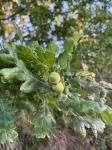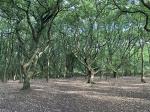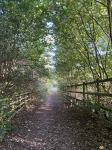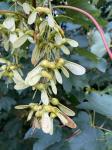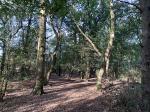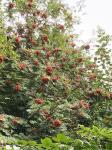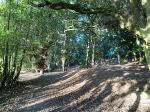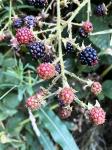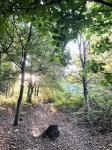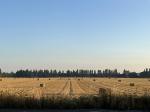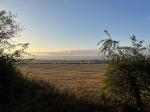Brayton Barff Through the Seasons.
Set in the Vale of York, South West of the market town of Selby and between the villages of Thorpe Willoughby and Brayton, lies Brayton Barff, a sandstone Hill approximately one hundred and fifty feet in height which was formed by glacial movement during the last Ice Age. It is a significant landmark in an otherwise flat landscape.
Today the site is primarily owned by Yorkshire Water with Selby District Council owning a small patch of the land adjacent to the A63 Selby bypass. A large underground reservoir occupies the centre of the site which delivers water to around 4.7 million customers throughout Yorkshire.
Within the Barff woodland over 40% of the trees are Sessile Oak which are generally found in semi natural woodlands in the north of the country. These trees are so called because its acorns are not held on stalks, like those of the English Oak (Pedunculate), but attached directly to the outer twigs. There are also several English Oak trees as well as some cross-hybrid oaks. These trees are known to support many species of flora and fauna, invertebrates, mosses, lichen and fungi.
During the Victorian times it is thought that the shipbuilders on the east coast would come over to the Barff for selected cuts of timber to build their sea going vessels.
The Barff also has a variety of other trees including Silver Birch, Beech, Sycamore, Holly, Rowan, Scots Pine, Alder, Hawthorne and European Larch. There are also several Yew, Willow, Hazel, Horse Chestnut and Wych Elm. As with similar woodlands there are a variety of bushes, including Honeysuckle, Elderberry, Gorse, Broom and Buddleia.
The history of Brayton Barff is quite vague, apparently during 1803 a beacon was lit on the Barff when the country was threatened with an invasion by Napoleon. In May 1935, to celebrate King George V's Silver Jubilee, a Bonfire was lit on the Barff as part of the celebrations.
Early issues of Ordnance Survey Maps dated 1903 clearly show a rifle range on the Barff, extending out to Mill Lane. During the 
Between 2001 – 2004 the A63 Selby bypass, 10km twin lane single carriageway was constructed which severed the South West corner of the Barff, adjacent to Selby Golf Course and resulted in a slight redesign of several holes on the golf course. Wooden fencing was erected as a result of this new road running alongside of the Barff and a footbridge constructed over the ‘new road’ following the line of the Bridal way which extends from Mill Lane. Around 2005/2006 a definite 2metre wide limestone aggregate footpath was laid forming a circular path around the outer edges of the woodland. This footpath is approximately 1.2 miles in length and takes about 30 minutes to circumnavigate at a leisurely pace.
In 2012 the Barff was declared an Ancient Oak Woodland and as such throughout 2012 and 2013 significant work had been carried out by the relevant agencies to cut and remove large swathes of non-native trees, creating at that time huge scars on the landscape. Some three years later the planting of the native trees have become well established and are flourishing. Ongoing maintenance work on the footpath around the bottom of the Barff was completed during the Summer of 2016.
A second phase of woodland maintenance commenced during the Autumn of 2019 with the removal of many old and diseased trees and the cutting back of the Gorse and Broom bushes, especially adjacent to the ‘bypass trail’, this work continued through till March 2020 with re planting continuing into April 2020.
Brayton Barff is a popular site for walkers and bird watchers alike and a path circling the outer perimeter of the Barff makes a pleasant thirty minute walk, giving views looking over towards Selby and the village of Brayton as well as the power stations of Drax and Eggborough..jpg)
For the early risers it is a great place to see some stunning sunrises over the villages of Brayton looking towards Drax Power Station, the same with the Sunsets looking over towards Eggborough and Monk Fryston.
The Barff changes with the Seasons and every visit can reveal something new, the woodland is a haven for wildlife. Records show that since 1982 one hundred and twelve species of bird have been seen in the woodland and at least 40 of those have bred here, including Tawny Owl, Buzzard, Green Woodpecker, Spotted Flycatcher, Goldcrest and Nuthatch to name just a few. On average over 70 species of bird are recorded each year. Further details of the bird life on the Barff can be found on the Brayton Barff Group Facebook page, especially the posts from Derek Cooper. Today ‘The Friends of Brayton Barff group’ led by Derek and a small team of volunteers help keep and maintain the cleanliness of the site as well as recording the wildlife and bird sightings.
The Barff is also home to fifteen different species of mammals, including Muntjac Deer, Pipistrelle Bat, Fox, and Field Vole.
Over eighty species of plant and wildflowers have been recorded, included Bee Orchid, Northern Marsh Orchid, Wood Anemone, Marsh Ragwort, Bluebell, White Bluebell, Bittersweet and Purple and White Foxgloves. Over twenty species of Butterfly have been recorded, including Marbled White, Brown Angus, Speckled Wood, Comma and Brimstone.
During the Autumnal months fungi thrives in this woodland environment, species including Fly Agaric, Beefsteak Tree Fungi, Chicken of the Wood, Sulphur Tufts, Stinkhorn, Ink cap, Puffballs and Hoof Bracket are just some of the many varieties that can be found here.
Click on the galleries shown below to expand the albums.
August 2022
Here’s my monthly round up of my wanders around Brayton Barff.
I sometimes wonder where the time has gone, here we are on the last day of August already with Autumn just around the corner.
August has been exceptionally dry on the Barff, like many other places in and around Yorkshire at this time. Many of the trees have started shedding their leaves in an effort to save energy, Elderberry bushes seem to have felt the dry conditions probably more so than others, with many bushes just dying back and shedding all their leaves, others seem to have been stunted, they should be amass of lush purple berries at the moment but on many of the bushes the berries have been shrivelled up due to the lack of rainfall. The Brambles in the woodland seem to be suffering a similar fate as the Elderberry, in that the lack of water has stunted the size of the fruit. That said it is not stopping the bramble briars from growing at an alarming rate. On a positive note, the established Oak trees are laden with Acorns and certainly making up for the poor show last year, the Rowan Tree/Mountain Ash trees are also heavily laden with bunches of bright red berries. The apple trees along both sides of the Bypass trail are also heavily ladened with fruit this year. Unfortunately, as a result of the lack of rain, it looks as though a lot of our wildflowers seem to have struggled with the dry conditions and have started to die back much earlier than they would have under normal damp ground conditions.
Midway through the month ‘Yorkshire water’ declared that the county was suffering from drought conditions and that a hosepipe ban would be implemented from the 26th of the month. Strangely enough from the Monday 15th to Friday 19th August, although our afternoon temperatures were in the mid 20C’s we had quite significant overnight rain every night that week, making for some very wet early morning dog walks on the Barff.
Temperatures during the month at around 6.30am in the morning as I arrive on the Barff, have ranged from 10C to 18C, which was quite pleasant, but some mornings became extremely humid, I’d even started to carry a couple of doggie water bottles for Meg & Gracie. By mid-afternoon the temperatures during the month had risen to the mid 30’s especially during the second week in the August with several days of ‘severe weather’ warnings being issued from the ‘Met office’ due to hot sunny weather. Several evenings during August have been uncomfortably warm too, I noted that on the 10th the temperature at 10.30pm was still 20C! making it quite uncomfortable to sleep.
It has been nice listening and watching a pair of Sparrowhawks raise its two chicks on the Barff this year. During the early part of August, situated on the edge of the woodland, close to the top of Tap Hill’ and the summit plateau, I would hear the chicks squealing for food, the chicks would be frantically calling for their breakfast, the calls only stopping once the parents had returned to the nest with food. By the end of the months the chicks fledged safely. Lower down and adjacent to the ‘old pump house’ a Buzzard could be seen and heard regularly feeding its chick in the paddock of what today is a private residence.
Although absent on the Barff for most of this year, I was pleased to hear the Green Woodpecker again, its distinctive yaffling call giving its location away, they, unlike the Greater Spotted Woodpecker, stay quite close to the ground feeding off insects and ants, and with the undergrowth being extremely dense at this time makes it very difficult to see them. On the other hand, the Greater Spotted Woodpecker can be seen and heard most days, their youngsters leaving the comfort and security of their nest very early on in the month, though by the time the chicks have fledged they are similar size to their parents, so it must have become quite congested and smelly in some of their nest holes.
I have counted at least four nest sites for Nuthatches around the woodland, their distinctive call seems to accompany me on my wanders.
It was good to see that by the third week into August the farmers had finally managed to get their fields harvested, the overnight rain during the middle of the month delaying the matter somewhat. They will be busy over the coming weeks preparing the fields to be planted up again with a winter crop. Several fields are still full of potatoes which will be harvested in the coming weeks.
Early autumn/September is the time when spiders become more active, and the males are on the lookout for a mate, and this is no different on the Barff. Towards the end of August, the spiders have been busily casting their webs, most of the webs are made during the previous evening and as I walk around the woodland early in the morning, I am continually getting covered with tiny strands of spiders webs which have been cast across the tracks and trails.
Fungi is beginning to become more noticeable of late, the ‘Chicken of the Woods’ especially visible not too far from the car park. Lots of ‘Polypore’ fungi are showing especially on the dead or rotting Silver Birch trees. I’ve noticed on several of the oak trees of late a ‘Beefsteak fungi’, this is a very distinctive reddish coloured fungi, the upper surface looks quite smooth and glossy coloured when wet, the underside being more pinky coloured.
The dry weather has turned much of the wild grass into hay and the sandy ground is beginning to crack, considering the time of year, school holidays, footfall, I am surprised that none of it has gone up in smoke. Unfortunately, one or two of the tree trunks look to have been deliberately set on fire, but fortunately the fires distinguished before they got out of hand. Litter still continues to be a daily problem, though usually decreases once the schools return after the summer holidays. Here’s hoping for some rain.
|





